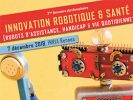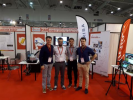Conférence Innovation, Robotique et Santé

Conférence Innovation, Robotique et Santé : robots d’assistance, handicap et vie quotidienne
Le Réseau Breizh PC et ses partenaires, vous donnent rendez-vous, vendredi 7 décembre au centre Inria Rennes – Bretagne Atlantique, pour cette nouvelle édition de la Conférence Innovation, Robotique et Santé, Le thème de cette année est consacré à la robotique de service et d’assistance dans la vie quotidienne, qui offre aujourd’hui des nouvelles perspectives d’accompagnement dans le champ du handicap et de la perte d’autonomie.









